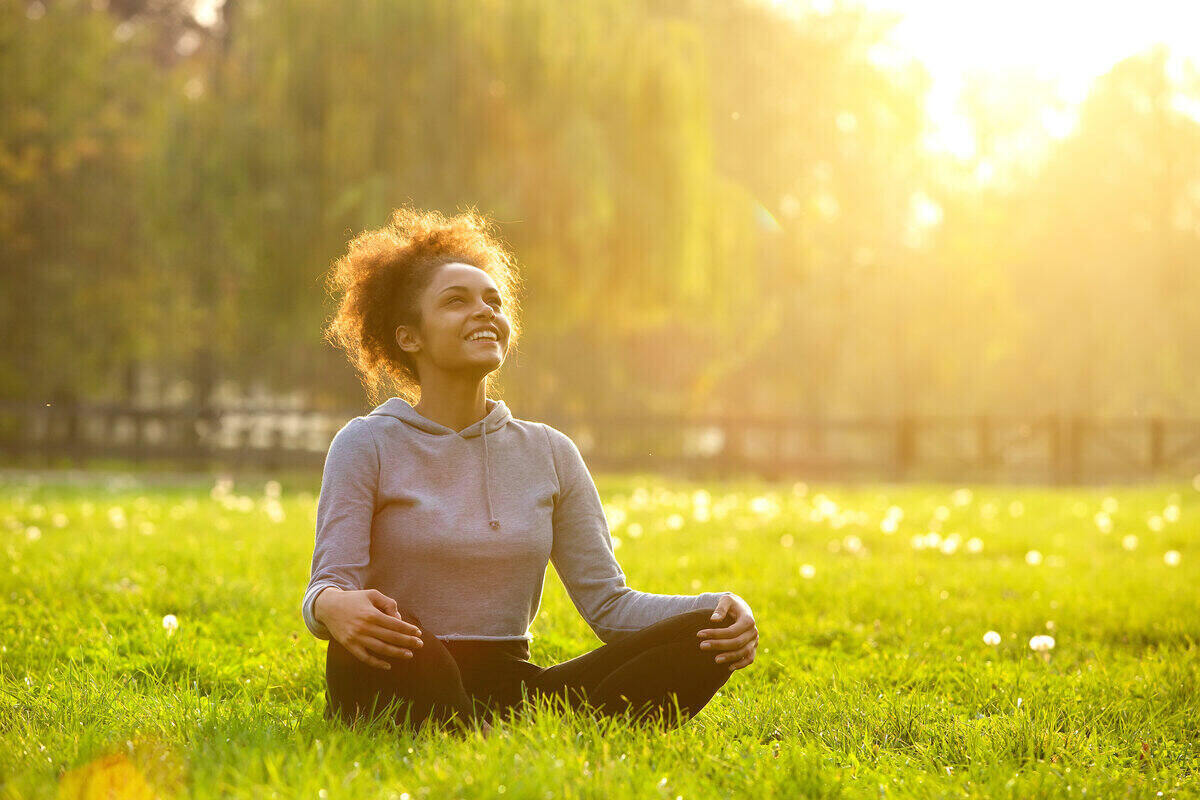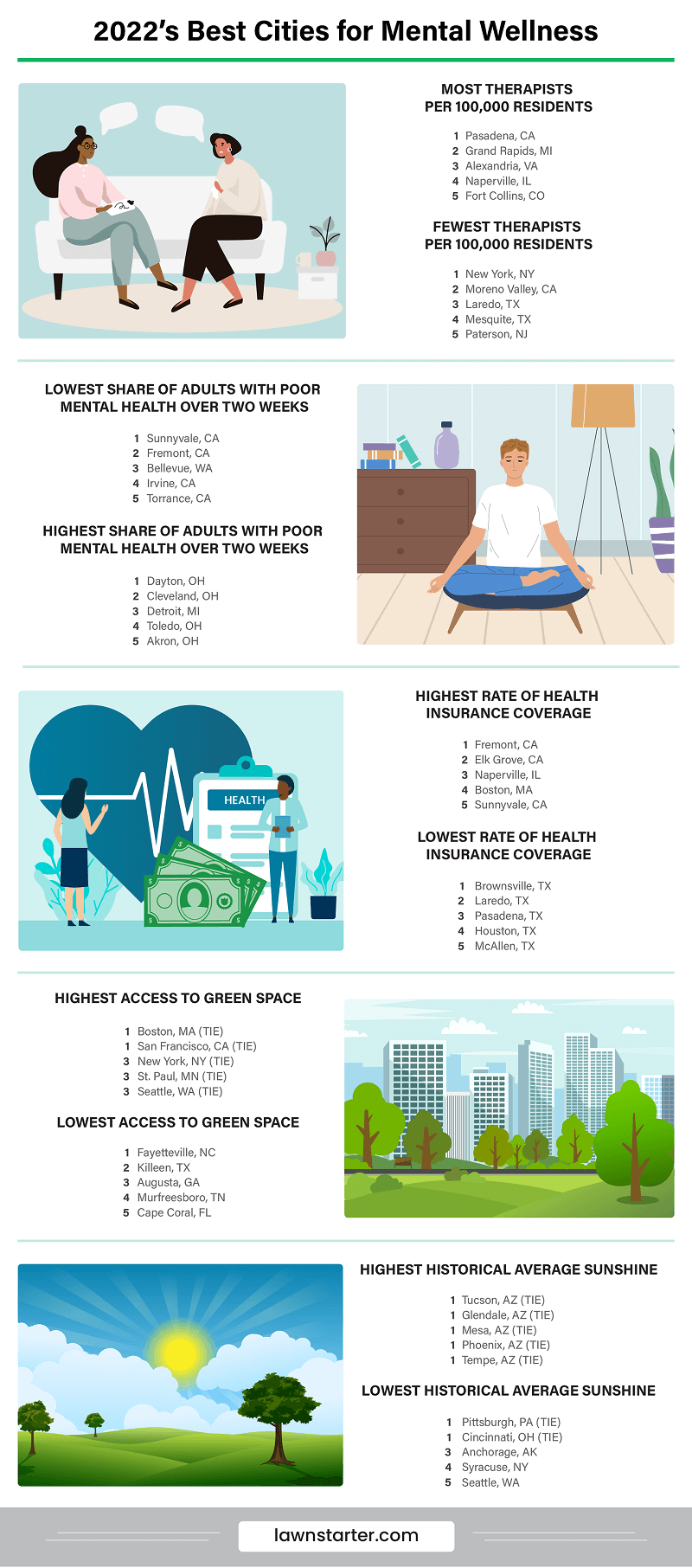
Your surroundings can have a big influence on how you’re feeling. A bit of sunshine, green space, and accessible mental health resources can go a long way.
So, which cities have the optimal environment for mental well-being?
To mark World Mental Health Day on Oct. 10, LawnStarter compared over 190 of the biggest U.S. cities to rank 2022’s Best Cities for Mental Wellness.
We considered 33 metrics based on mental, physical, social, financial, and environmental factors. These include factors like access to therapists, cost of living, average sleep levels, meditation classes, and urban gardening-friendliness.
See how your city is doing below, followed by our analysis and expert tips.
Contents
- City Rankings
- Highlights and Lowlights
- Mental Wellness By the Numbers
- Ask the Experts
- Methodology
- Take a Mindful Moment
City Rankings
See how each city fared in our ranking:

Highlights and Lowlights
Suburban Satisfaction
They say money can’t buy happiness — but it can pay for therapy. No wonder wealthy satellite cities landed at the top of our ranking.
Naperville, Illinois, takes first place overall and in Financial Wellness. A small share of adults with poor mental health and low divorce rates brought this city to the top. Similar rankings lifted Pasadena, California (No. 2), Bellevue, Washington (No. 6), and Alexandria, Virginia (No. 7). These cities are full of therapists, as well as healthy, financially stable, and well-rested adults.
Pasadena has the best access to mental health services, with more than 556 therapists per 100,000 residents. The City of Roses also boasts the most meditation classes. Naperville has the least crime (No. 1), while Alexandria is great for getting that extra boost of dopamine from biking and other exercise opportunities (No. 1).
West Coast Wellness
The laidback West Coast dominates our ranking, with Pacific cities taking up more than half of our top 20. Meditation, running, biking, yoga, and hiking are popular in this region. Movement and mindfulness can help balance hormones, reduce anxiety, and improve cognitive function.
In addition to their high scores in Physical Wellness and Mindfulness factors, Seattle (No. 3) and San Francisco (No. 5) impress with high access to therapy, green space, and sufficient sleep. Furthermore, California cities Fremont (No. 4), Irvine (No. 8), and San Diego (No. 12) have low divorce rates. Each of these five cities has low levels of poor mental health and unemployment.
However, not all that glitters is gold: Under the serene surface, long work hours, binge drinking, and drug overdose deaths put a strain on San Fran and Seattle.
Fit Minds
Outside of our top 10 cities, Grand Rapids, Michigan (No. 38), Atlanta (No. 20), and Pittsburgh (No. 67) have the next best access to local mental health providers.
Getting some exercise can help a lot when you can’t afford (or simply don’t have access to) mental health services. While Fort Collins, Colorado (No. 9), and Salt Lake City (No. 14) each have ample therapy access, they also have high rates of Physical Wellness (No. 3 and No. 2, respectively).
Working long hours and getting limited sleep can be detrimental to physical and mental health. Sometimes, the best thing for your body and mind is simply to slow down and rest. Fort Collins is also the most well-rested city, followed by Bellevue, Washington; Minneapolis; and Overland Park, Kansas. Meanwhile, New York cities Syracuse and Buffalo, along with Dayton, Ohio, have the lowest average weekly work hours.
Big-City Blues
Cities with large populations like Chicago (No. 86), Washington (No. 58), and Los Angeles (No. 43) did not fare as well as their top-ranking suburbs.
These three cities — and New York (No. 77) — have high rates of poverty and unemployment. Residents in Chicago and Washington also suffer from higher rates of binge drinking and drug overdoses, long work hours, and poor weather. Additionally, Chicagoans and Angelenos experience higher rates of poor health, and NYC is severely lacking in access to therapists (No. 192).
At the very bottom of our ranking lie less populated cities like Detroit in last place, followed by Cleveland and Kansas City, Kansas. Each of these cities has substandard scores across the board, with particularly low access to mental health support, financial frailty, and unappealing weather.
Mental Wellness By the Numbers
Ask The Experts
Improving mental well-being can be a daunting endeavor for some, especially with the current state of the nation’s mental health care. We contacted a panel of experts to learn more about how to improve mental wellness. Read what they had to say below.
- With a psychiatrist shortage and limited mental health services available in many regions, what is one of the best free ways to boost your mental health?
- What is one way employers can benefit their workers’ mental well-being?
- What are three most common warning signs that someone is struggling with their mental health?
- What are the best first steps for someone who is considering seeking mental health treatment? What is one thing they should keep in mind or watch out for?
- More than 50% of adults with mental illness do not receive treatment. What is one way that cities can make therapy and other mental health treatments more accessible?


Methodology
For each of the 200 biggest U.S. cities, we gathered publicly available data on the factors listed in the table below.
We then grouped those factors into five categories: Mental Wellness and Access, Physical Wellness, Mindfulness and Social Wellness, Financial Wellness, and Environment.
Next, we calculated weighted scores for each city in each category.
Finally, we averaged the scores for each city across all categories. We eliminated 8 cities lacking sufficient data in a single category, resulting in a final sample size of 192 cities.
The city that earned the highest average score was ranked “Best” (No. 1), while the city with the lowest was ranked “Worst” (No. 192). (Note: The “Worst” among individual factors may not be 192 due to ties among cities.)
Sources: Areavibes, Centers for Disease Control and Prevention, County Health Rankings & Roadmaps, Lawn Love, National Center for Disaster Preparedness, National Oceanic and Atmospheric Administration, Neighborhood Scout, Other LawnStarter Studies, Psychology Today, Trust for Public Land, U.S. Bureau of Labor Statistics, U.S. Census, U.S. Environmental Protection Agency, and Yelp
Take a Mindful Moment
Social isolation, post-pandemic stress, and inflation have left the nation riddled with depression and anxiety.
Fortunately, more people are getting access to mental health services than in previous years, thanks to reduced stigma and increased support. Yet many are still without access due to the current shortage of mental health professionals.
Getting access to mental health counseling can be difficult, especially if your metro is lacking in therapists. Thankfully, there are plenty of online options available for you to attend a telehealth therapy session from the comfort of your home.
There’s no simple fix to improving your mental health, but there are still some things you can do to feel better:
Meditate
Mindfulness meditation can help with managing stress, depression, and anxiety. Evidence shows that meditation can help relieve pain, decrease blood pressure, and improve sleep quality. Itching for a relaxing trip? Sign up for a mindfulness retreat.
Grow a garden
Get some plant friends to help cultivate your mental wellness, even if you live in a city. If you don’t have the time, energy, or will to grow a garden of your own, strolling through romantic gardens around your city can be a reviving way to spend your afternoon.
Cook something
Slowing down and taking the time to cook a meal from scratch can be a relaxing way to boost focus, confidence, and emotional well-being. Crafting a tasty, nutritious meal from ingredients in your kitchen can make you feel better physically, too.
Rest up
It’s important to get some sleep and reset your brain. Rest is important, and lack of sleep could even worsen your mental health.
Volunteer
Find an organization in your city that matters to you, and see if they’re taking on any new volunteers. By volunteering with them, you’ll likely meet new people, learn new skills, and gain a sense of purpose.
Try something new
Get a dopamine boost by learning something or having a new experience. For inspiration, you could study a language, eat at a new brunch spot, or learn how to craft a DIY project.
Move your body
Whether you prefer walking, running, hiking, biking, recreational sports, or yoga, there are numerous benefits to being active. Regular exercise can alleviate depression and anxiety, improve sleep, and reduce stress. With many people working from home these days, it’s especially important to prioritize physical activity and get outside.
Mow the lawn
Yes, even mowing the lawn can improve mental well-being. Spending time in your yard getting fresh air, moving your body, and smelling freshly cut grass can help boost your mood (unless you have a grass allergy). If the yard chores are piling up and adding to your stress, hire a local LawnStarter pro to take care of them instead.
Main Photo Credit: Shutterstock






